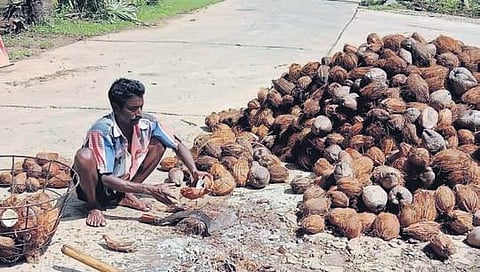Inundated fields add to Konaseema villagers’ woes
SERILANKA (KONASEEMA DISTRICT): Water-level in the River Godavari might be receding, but the flood-affected people in the villages of Dr BR Ambedkar district are yet to come out of the misery the deluge has left them with. Konaseema is known for its lush-green fields, but with most of the farm lands inundated, villagers are facing a severe crisis due to lack of agriculture-related jobs.
In villages like Serilanka, Kothalanka, Pottithippa and Kamini, 80 per cent of the people are dependent on agriculture. These four villages, bordering each other, are located in four different mandals.Narrating his ordeal, S Raju of Serilanka said, “Water reached a height of five feet in our village. We were shifted to a rehabilitation centre on July 9. After 10 days, we returned home as the waters had receded. But we did not have any work as farming activity is yet to start.”
dependent on agriculture | Express
Like Raju, several villagers are left with little or no work. The only few jobs available are to segregate damaged coconuts. Konaseema is famous for its coconut groves, but the rains and floods did not spare them either.“If coconuts remain in water for a long time, they will get damaged, leaving us with losses. The next harvesting season will begin only after six months,” S Srinu, a coconut farmer said.
Another farmer from Kothalanka in Tallarevu mandal, Dukkipati Baboji, used to cultivate crops in five acres. The yield would be sufficient for his family.“The crop is totally damaged now. Apart from my family, I have to feed my cattle also. So far, I have borrowed Rs 45,000 from lenders,” he rued.
Providing fodder to cattle has also become a difficult task as neither dry nor fresh grass is available. Farmers have to travel long distances to get feed for the cattle. Gurrala Subba Rao of Kamini had cultivated sesame in two acres, which was completely damaged. “I have spent Rs 15,000 to buy dry grass from neighbouring village for six cattle heads. The situation in all other villages is similar,” Subba Rao said. Feeding the cattle has become even more vital now.
With fields being submerged, milk production has become the only source of income for the farmers. “We are purchasing grass even though we have to travel for long distances. Milk is now our only source of livelihood,” another farmer said. Sesame, corn, chilli and banana are internal crops cultivated in the region. For most villagers removing weeds from crops, spraying pesticides, digging internal canals for free flow of water, making holes for water to coconut trees, also helps them make money.
Speaking to TNIE, Mandal Development Officer of K Gangavaram, N Srinivas said the villagers were given shelter at rehabilitation centres in July for 10 days. After the water receded, the government gave Rs 2,000 to each deluge-hit family. “NREGS works will be created for the flood-affected villagers to provide immediate employment, if needed, as agriculture and horticulture have been affected. The village level staff held surveys to identify the needy people,” he said.

